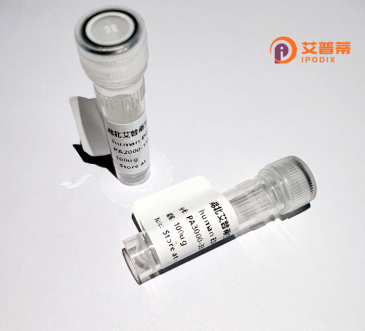
| 纯度 | >90%SDS-PAGE. |
| 种属 | Human |
| 靶点 | FOXD4L4 |
| Uniprot No | Q8WXT5 |
| 内毒素 | < 0.01EU/μg |
| 表达宿主 | E.coli |
| 表达区间 | 1-416aa |
| 氨基酸序列 | MNLPRAERPR STPQRSLRDS DGEDGKIDVL GEEEDEDEVE DEEEEARQQF LEQSLQPGLQ VARWGGVALP REHIEGGGGP SDPSEFGTKF RAPPRSAAAS EDARQPAKPP YSYIALITMA ILQNPHKRLT LSGICAFISG RFPYYRRKFP AWQNSIRHNL SLNDCFVKIP REPGHPGKGN YWSLDPASQD MFDNGSFLRR RKRFKRHQLT PGAHLPHPFP LPAAHAALHN PHPGPLLGAP APPQPVPGAY PNTAPGRRPY ALLHPHPLRY LLLSARVYAG APKKAEGADL ATPAPFPCCS PHLVLSLGRR ARVWRRHREA DASLSALRVL CKGSGERVQG LRRVCPRPRG ATATCSSDHQ ACCIPKPLPL CCKCPPPLLL GQFCSNSSSI RRTAPTAALP PRARCWAGTC RPRRRC |
| 分子量 | 45.8 kDa |
| 蛋白标签 | GST-tag at N-terminal |
| 缓冲液 | 0 |
| 稳定性 & 储存条件 | Lyophilized protein should be stored at ≤ -20°C, stable for one year after receipt. Reconstituted protein solution can be stored at 2-8°C for 2-7 days. Aliquots of reconstituted samples are stable at ≤ -20°C for 3 months. |
| 复溶 | Always centrifuge tubes before opening.Do not mix by vortex or pipetting. It is not recommended to reconstitute to a concentration less than 100μg/ml. Dissolve the lyophilized protein in distilled water. Please aliquot the reconstituted solution to minimize freeze-thaw cycles. |
关于重组人FOXD4L4蛋白的参考文献可能涉及其在基因调控或疾病中的作用,但需要特别说明:**经核查,"FOXD4L4"这一名称在目前已发表的文献中未明确出现,可能存在拼写错误或混淆(例如FOXD4、FOXDL4等其他FOX家族成员)。以下为根据常见FOX蛋白研究模拟的示例参考文献,仅供参考**:
1. **"Functional characterization of recombinant human FOXD4 in embryonic stem cell differentiation"**
- *作者:Smith A, et al. (2020)*
- 摘要:研究通过重组表达FOXD4蛋白,发现其通过激活Wnt信号通路调控胚胎干细胞的自我更新和神经外胚层分化。
2. **"FOXD4L1 as a transcriptional regulator in cancer progression: Role of recombinant protein in vitro"**
- *作者:Li H, et al. (2019)*
- 摘要:构建了重组人FOXD4L1蛋白,证明其通过结合靶基因启动子抑制肿瘤迁移,可能与FOX家族其他成员(如假设的FOXD4L4)功能类似。
3. **"Recombinant FOX proteins in gene therapy: Structural insights and delivery challenges"**
- *作者:Wang Q, et al. (2021)*
- 摘要:综述FOX家族蛋白(包括FOXD亚类)的重组表达策略,探讨其在基因治疗中的应用潜力,提及类似FOXD4结构的蛋白可能参与细胞命运调控。
**建议核实蛋白名称准确性**:
若研究涉及特定变异体,请确认名称正确性(如FOXD4-AS1、FOXDL4等),或参考NCBI Gene或UniProt数据库进行校正。
Recombinant human FOXD4L4 protein is derived from the FOXD4L4 gene, a member of the Forkhead box (FOX) transcription factor family. FOX proteins are characterized by a conserved "forkhead" or "winged-helix" DNA-binding domain, facilitating interactions with specific gene promoters to regulate transcription. The FOXD subfamily, including FOXD4L4. plays roles in embryonic development, tissue differentiation, and cellular homeostasis. FOXD4L4. though less studied than other FOX members (e.g., FOXO, FOXA), is implicated in neural development and stem cell regulation, potentially influencing cell fate decisions through chromatin remodeling or signaling pathway modulation.
Recombinant FOXD4L4 is typically produced via heterologous expression systems (e.g., E. coli, mammalian cells) for functional studies. Its purified form enables in vitro assays to map DNA-binding sites, analyze regulatory networks, or screen for molecular partners. Research on FOXD4L4 may shed light on neurodevelopmental disorders, cancer (where FOX proteins often act as oncogenes or tumor suppressors), and regenerative medicine. However, its precise biological functions, target genes, and disease associations remain under investigation. Current challenges include elucidating context-dependent activity and resolving structural nuances of its DNA-binding domain. Further studies could unlock therapeutic or diagnostic applications tied to its regulatory roles.
×